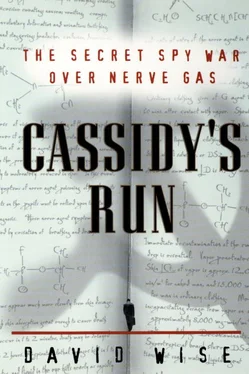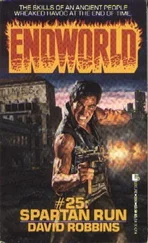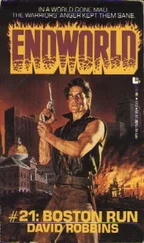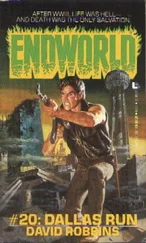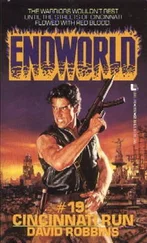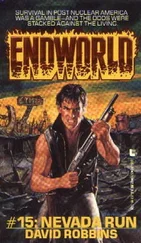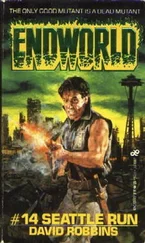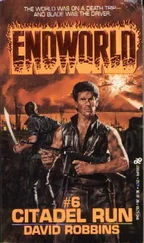Although the FBI could watch Lopez receiving radio signals, they could not read the content of the encoded messages. Determined to decode the encrypted signals, the FBI again waited until the Lopezes were away on a trip. Using the door key that Lopez had sent to Flores, FBI agents entered the apartment and copied the “one-time pads” containing the random numbers that Lopez used to decode his radio signals. [5] One-time pads, usually no bigger than a postage stamp, are printed on nitrated cellulose, which burns instantly. A spy receiving a message in encoded five-digit groups first subtracts the random numbers on the one-time pad and then converts the resulting total into words from a matrix containing the letters of the alphabet. Each page is used only once and burned. Since only two copies of the pad exist, one in Moscow and one in the possession of the spy, the codes are virtually unbreakable.
Now the FBI was able to decipher and read all of PALMETTO’S messages.
“He would burn the pages of the one-time pads after using them,” Flores said. But destroying the pages no longer made any difference; the FBI had them.
Lopez received a wide variety of encoded messages from the Russians. Flores recalled, “Some Soviet agents were being thrown out of England, and he would get a message, ‘Don’t worry, you’re in no danger.’ Some were, ‘Cancel plan A, we are doing plan B.’ He would be told to go to Mexico or Florida. And some were personal messages, ‘Congratulations on your son’s birthday,’ or your birthday. Or, ‘We are very happy with what you’re doing. You’re doing a marvelous job for us.’ The messages were brief.”
The video camera enabled the FBI to read some of the messages at the very moment that Lopez decoded them. “When he wrote something on his notepad, we could see it,” Flores said. The camera also revealed the tensions in the Lopez household. All was not harmonious on the domestic front, according to Charlie Bevels. “At one point she [Mrs. Lopez] had a gun and pointed it at him and told him to quit bugging her. She was going to blow his head off.”
After some months,Lopez and his family moved out of the duplex and into a single-family house in another section of Austin. The couple also acquired a large, unfriendly dog, Flores recalled. “They bought this big black female dog, a German shepherd, named Brea, which means black tarin Spanish. A big vicious dog, barked a lot. I became friends with the dog. I made sure I played with the dog and fed the dog, so if they [FBI technicians] needed to go in, I could go in. But when the PALMETTOS went on a trip, they took the dog with them, so that problem did not come up.”
Lopez continued to service the drops in Florida. On the night of September 10, 1972, Joe Cassidy left a rock at a new drop site at Anvil Street and Twenty-sixth Avenue North, in St. Petersburg. The film contained one document stamped SECRET and several marked with lower classifications. The document stamped SECRET must have pleased Danilin because it was the first to deal with nuclear weapons. Dated February 1, 1972, it was entitled “Operational Feasibility in Mating Nuclear Bombs to Aircraft.” A March 1971 document marked CONFIDENTIAL was headed “General Flag Officer Staffing in OJCS and JCS Activities.”
The factory of the Morgan Yacht Company overlooked the drop site, and O’Flaherty and his agents, having obtained permission from the owner, were waiting on scaffolds along the windows inside. “Lopez arrives at 9:27 P.M. in a white Pontiac with black hardtop, with his wife and son,” O’Flaherty said. The car parked at the corner. Lopez got out, knelt at the stop sign, and picked up the hollow rock. He returned to the car, and they drove off.
Nearly two months later, on November 2, Cassidy received a letter from Danilin. The paper inside appeared blank, as usual. When he developed the secret writing and showed it to the FBI, the message was unnerving. Danilin asked by name for specific U.S. military documents that he wanted. How could the GRU have obtained such a shopping list of secret documents? The implication was both obvious and scary: Moscow had a genuine mole buried somewhere in the American military, perhaps one who had access to an index or list of classified material but not to the actual documents.
One document Danilin requested was entitled “Vol. II — Joint Strategic Objectives Plan for Fiscal Year 1975-1982 (USOPFY 75-82).” Danilin also asked Cassidy for data on the yield and number of warheads of Minuteman III and Poseidon missiles.
Then in December, five days before Christmas, Cassidy put down another rock at the street sign by the marina along Bay Shore Drive. Inside was film of four documents marked SECRET and of others with lower classification stamps. The document marked SECRET, although not the one Danilin had requested, was dated September 19, 1972, and was called “Nuclear Capabilities Reporting, JCS message No. 5252.”
At 9:22 P.M., a yellow compact with Florida plates cruised by the drop site. Four minutes later, Lopez was seen alone nearby, walking south on Bay Shore Drive. At the street sign, he picked up the rock, put it in a camera case, and strolled away. Lopez had checked into the St. Petersburg Hilton the day before at dawn. He checked out the next day and took a Greyhound bus to Washington, D.C.
The next drop in St. Petersburg took place on April 1, 1973. The Russians had approved a new drop site in a quiet residential area at Eighty-ninth Avenue North and Fifth Street North. Casing the area, O’Flaherty saw that it was next to a construction site. The builder, Aaron Applefield, allowed the FBI to use the model home on the site as a lookout post. Fred and Pearl Redfield, an elderly couple whose home overlooked the drop site, also allowed the FBI to use their house. An agent loitered on the street in a phone booth.
Cassidy put down his hollow rock at 9 P.M. It contained photographs of three documents stamped SECRET and of several others marked with lower classifications. At 9:33 P.M., the waiting agents spotted Lopez driving alone near the drop site in a yellow late-model Fiat. A moment later, Lopez, with his German shepherd on a leash, approached the corner, doing his best to look like a neighborhood resident out walking his dog. He picked up the rock, got back in the Fiat, and took off.
Lopez then drove to Washington. Again not wanting to alarm the spy, the FBI did not tail the car but instead set up a “picket surveillance,” with agents stationed along his likely route.
This was the last drop and pickup in Florida. One month earlier, Cassidy, at age fifty-two, with thirty years in the service, had retired from the army. That did not discourage the Soviets, who were making plans to use their mole in a new capacity. WALLFLOWER had left the military but not his life as a spy.
In Austin, thePALMETTO case took a bizarre and astonishing twist. Flores had done his job so well that Lopez tried to recruit him.
“He came by one night and pitched me in my living room in Texas. He wanted to recruit me. He said, ‘I have friends in Mexico that work for another government. I told them about you, and they are very interested.’ He asked to take a photograph of me ‘to show to my friends.’ I said sure, so he took a photograph of me.
“He said, ‘They won’t come here, you have to go to Mexico.’”
Headquarters debated the risks of letting Flores travel to Mexico. “Finally, the bureau said, ‘No, don’t go. You know too much about the technical side.’ The cameras we used in Austin that worked through the pinpricks in the ceiling were the same kind that were used by NASA in the moon landing. We got the cameras from NASA. The bureau didn’t want the Soviets to know we had that technology. They were concerned I might be invited to Nicaragua or the Soviet Union and given sodium Pentothal.”
Читать дальше
